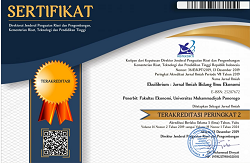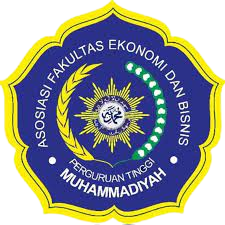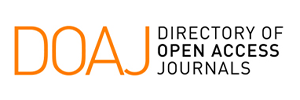The Role of Performance Political Stability and Macroeconomic Attracting Foreign Direct Investment in ASEAN
DOI: 10.24269/ekuilibrium.v19i1.2024.pp107-121
Abstract
Foreign direct investment (FDI) plays a crucial role in developing nations to raise the standard of living for their citizens and strengthen their economies. This research aims to investigate the effects of macroeconomic factors like GDP, inflation, and female employment in the industry on flows of foreign direct investment as well as factor political stability with a research focus on 5 ASEAN countries (Indonesia, Malaysia, Vietnam, Laos, Cambodia) with research 20 years. The research method used panel data regression with secondary data from the World Bank. The Fixed Effect Model is found to be the best model selection. The results showed that political stability variables as well as all macroeconomic fundamental variables as measured by GDP, Inflation, and Employment Females in Industry partially had a significant and positive effect on the inflow of Foreign direct investment in 5 ASEAN countries and simultaneously had a significant positive effect.
Keywords
References
- Abdillah, K., Handoyo, R. D., & Wasiaturrahma, W. (2020). The Effect of Control Corruption, Political Stability, Macroeconomic Variables on Asian Economic Growth. Ekuilibrium : Jurnal Ilmiah Bidang Ilmu Ekonomi, 15(2), 161. https://doi.org/10.24269/ekuilibrium.v15i2.2678
- Agudze, K., & Ibhagui, O. (2021). Inflation and FDI in industrialized and developing economies. International Review of Applied Economics, 35(5), 749–764. https://doi.org/10.1080/02692171.2020.1853683
- Agustin, E. B., Muljaningsih, S., & Asmara, K. (2021). Analisis Faktor-Faktor Yang Mempengaruhi Foreign Direct Investment (Fdi) Di Singapura Tahun 2004-2019. Equilibrium : Jurnal Ilmiah Ekonomi, Manajemen Dan Akuntansi, 10(2), 105–112. https://doi.org/10.35906/je001.v10i2.778
- Akin, T. (2019). The effects of political stability on foreign direct investment in fragile five countries. Central European Journal of Economic Modelling and Econometrics, 2019(4), 237–255. https://doi.org/10.24425/cejeme.2019.131539
- Ashurov, S., Abdullah Othman, A. H., Rosman, R. Bin, & Haron, R. Bin. (2020). The determinants of foreign direct investment in Central Asian region: A case study of Tajikistan, Kazakhstan, Kyrgyzstan, Turkmenistan and Uzbekistan (A quantitative analysis using GMM). Russian Journal of Economics, 6(2), 162–176. https://doi.org/10.32609/J.RUJE.6.48556
- Badriah, L. S., & Istiqomah, I. (2022). Does Gender Inequality Lead to Income Inequality? Evidence From Indonesia. Ekuilibrium : Jurnal Ilmiah Bidang Ilmu Ekonomi, 17(1), 1. https://doi.org/10.24269/ekuilibrium.v17i1.4003
- Baloch, M. A., Zhang, J., Iqbal, K., & Iqbal, Z. (2019). The effect of financial development on ecological footprint in BRI countries: evidence from panel data estimation. Environmental Science and Pollution Research, 26(6), 6199–6208. https://doi.org/10.1007/s11356-018-3992-9
- Bitar, N., Hamadeh, M., & Khoueiri, R. (2019). Impact of Political Instability on Foreign Direct Investment in Lebanon. Asian Social Science, 16(1), 41. https://doi.org/10.5539/ass.v16n1p41
- Brueckner, M., Dabla-Norris, E., Gradstein, M., & Lederman, D. (2018). The rise of the middle class and economic growth in ASEAN. Journal of Asian Economics, 56. https://doi.org/10.1016/j.asieco.2017.12.008
- Crescenzi, R., Di Cataldo, M., & Giua, M. (2021). FDI inflows in Europe: Does investment promotion work? Journal of International Economics, 132(June). https://doi.org/10.1016/j.jinteco.2021.103497
- Cung Huu NGUYEN. (2021). Labor Force and Foreign Direct Investment: Empirical Evidence from Vietnam. Journal of Asian Finance, Economics and Business. Journal of Asian Finance Economics and Business, 8 (1), 103–112. https://doi.org/10.13106/jafeb.2021.vol8.no1.103
- Dabrowski, M. (2019). Factors determining Russia’s long-term growth rate. Russian Journal of Economics, 5(4), 328–353. https://doi.org/10.32609/j.ruje.5.49417
- Demina, Y. A. (2022). EAEU and ASEAN: Reasons for differences in FDI inflows with similar integration models. RUDN Journal of Economics, 30(4), 449–466. https://doi.org/10.22363/2313-2329-2022-30-4-449-466
- Dinh, T. T.-H., Vo, D. H., The Vo, A., & Nguyen, T. C. (2019). Foreign Direct Investment and Economic Growth in the Short Run and Long Run: Empirical Evidence from Developing Countries. Journal of Risk and Financial Management, 12(4), 176. https://doi.org/10.3390/jrfm12040176
- Erkekoglu, H. (2016). 6. Do political risks affect the foreign direct investment inflows to host countries. Pressacademia, 5(2), 218–218. https://doi.org/10.17261/pressacademia.2016219263
- Erum, N., Hussain, S., & Yousaf, A. (2016). Foreign Direct Investment and Economic Growth in SAARC Countries. The Journal of Asian Finance, Economics and Business, 3(4), 57–66. https://doi.org/10.13106/jafeb.2016.vol3.no4.57
- Ezeji E, C., Chijindu Promise, U., & Uzoamaka S, C. (2015). Impact of Capital Inflows on Economic Growth of Developing Countries. The International Journal of Management Science and Business Administration, 1(7), 7–21. https://doi.org/10.18775/ijmsba.1849-5664-5419.2014.17.1001
- Fajar Nurbani Aslam, & Ari Rudatin. (2023). Analisis determinan aliran Foreign Direct Investment (FDI) di kawasan ASEAN. Jurnal Kebijakan Ekonomi Dan Keuangan, 1(2), 205–211. https://doi.org/10.20885/jkek.vol1.iss2.art7
- Hoang, H. H., & Bui, D. H. (2015). Determinants of foreign direct investment in ASEAN: A panel approach. Management Science Letters, 5(2), 213–222. https://doi.org/10.5267/j.msl.2014.12.015
- Hussain, M. E., & Haque, M. (2016). Foreign direct investment, trade, and economic growth: An empirical analysis of bangladesh. Economies, 4(2), 1–14. https://doi.org/10.3390/economies4020007
- Jaiblai, P., & Shenai, V. (2019). The determinants of FDI in sub-Saharan economies: A study of data from 1990–2017. International Journal of Financial Studies, 7(3). https://doi.org/10.3390/ijfs7030043
- Kadiša, T., Butkus, M., & Aleksandravičienė, A. (2021). Effect of Foreign Direct Investment on Growth-Unemployment Nexus. Socialiniai Tyrimai, 44(2), 139–152. https://doi.org/10.15388/soctyr.44.2.9
- Khushnood, E., Channa, Z. H., Bhutto, M., & Ali Erri, M. (2020). Impact of Good Governance Indicators on the Inflow of Foreign Direct Investment (FDI) In Pakistan. NICE Research Journal, 13(2), 69–83. https://doi.org/10.51239/nrjss.v0i0.175
- Kirana, Y. S. (2022). Pengaruh Produk Domestik Bruto dan Ekspor Terhadap Foreign Direct Investment di Indonesia, Thailand, dan Vietnam. Jurnal Ekonomi Aktual, 2(2), 73–78. https://doi.org/10.53867/jea.v2i2.51
- Kurul, Z., & Yasemin Yalta, A. (2017). Relationship between institutional factors and FDI flows in developing countries: New evidence from dynamic panel estimation. Economies, 5(2). https://doi.org/10.3390/economies5020017
- Li, W., Nie, G., & Wang, Z. (2020). Trade, FDI, and Global Imbalances. Journal of International Money and Finance, 105(February). https://doi.org/10.1016/j.jimonfin.2020.102188
- Manan, S. A., & Aisyah, S. (2023). Pengaruh Produk Domestik Bruto, Tingkat Suku Bunga, Inflasi, dan Pertumbuhan Ekonomi terhadap Foreign Direct Investment di Asean. Ekonomis: Journal of Economics and Business, 7(1), 159. https://doi.org/10.33087/ekonomis.v7i1.764
- Marsh. (2019). Politcal Risk Map 2019: Rising geopolitical tensions. Marsh & McLennan Companies, February. https://bit.ly/3iTWlSd
- Mohamed, E. A. (2019). The impact of political reform on the stability of the state of Kuwait since 2010. Journal of Humanities and Applied Social Sciences, 2(2), 101–114. https://doi.org/10.1108/jhass-06-2019-0001
- Nasir, M. A., Duc Huynh, T. L., & Xuan Tram, H. T. (2019). Role of financial development, economic growth & foreign direct investment in driving climate change: A case of emerging ASEAN. Journal of Environmental Management, 242, 131–141. https://doi.org/10.1016/j.jenvman.2019.03.112
- Ngo, M. N., Cao, H. H., Nguyen, L. N., & Nguyen, T. N. (2020). Determinants of foreign direct investment: Evidence from Vietnam. Journal of Asian Finance, Economics and Business, 7(6), 173–183. https://doi.org/10.13106/JAFEB.2020.VOL7.NO6.173
- Nguyen, H. H. (2020). Impact of foreign direct investment and international trade on economic growth: Empirical Study in Vietnam. Journal of Asian Finance, Economics and Business, 7(3), 323–331. https://doi.org/10.13106/jafeb.2020.vol7.no3.323
- Noviani, I. D., & Istifadah, N. (2020). Analisis Pengaruh Tenaga Kerja dan Pengeluaran Pemerintah (Infrastruktur) terhadap Investasi di Indonesia. Media Trend, 15(2), 283–290. https://doi.org/10.21107/mediatrend.v15i2.6703
- Omodero, C. O. (2019). Effect of Corruption on Foreign Direct Investment Inflows in Nigeria. Studia Universitatis Vasile Goldis Arad, Economics Series, 29(2), 54–66. https://doi.org/10.2478/sues-2019-0008
- Paul, S. C., Rosid, M. H. O., Xuefeng, Z., & Islam, M. R. (2021). The macroeconomic determinants of cross-country FDI flows: A comparative analysis through the driscoll-kraay, 2SLS and GMM models. Asian Economic and Financial Review, 11(2), 129–140. https://doi.org/10.18488/JOURNAL.AEFR.2021.112.129.140
- Piketty, T., Saez, E., & Zucman, G. (2018). Distributional National Accounts: Methods and Estimates for the United States*. The Quarterly Journal of Economics, 133. https://doi.org/10.1093/qje/qjx043
- Putri, N. K., Komara, K., & Setyowati, T. (2021). Pengaruh Nilai Tukar, Pertumbuhan Ekonomi, Inflasi, dan Suku Bunga terhadap Investasi Asing Langsung di Indonesia. Jkbm (Jurnal Konsep Bisnis Dan Manajemen), 8(1), 11–25. https://doi.org/10.31289/jkbm.v8i1.5422
- Rahim, D. A. (2023). Reviewing the Role of Investment in the West Kalimantan Border. Ekuilibrium : Jurnal Ilmiah Bidang Ilmu Ekonomi, 18(1), 83–93. https://doi.org/10.24269/ekuilibrium.v18i1.2023.pp83-93
- Rashid, M., Looi, X. H., & Wong, S. J. (2017). Political stability and FDI in the most competitive Asia Pacific countries. Journal of Financial Economic Policy, 9(2), 140–155. https://doi.org/10.1108/JFEP-03-2016-0022
- Sabir, S., Rafique, A., & Abbas, K. (2019). Institutions and FDI: evidence from developed and developing countries. Financial Innovation, 5(1). https://doi.org/10.1186/s40854-019-0123-7
- Sahu, J. (2020). Does inflow of foreign direct investment stimulate economic growth? Evidence from developing countries. Transnational Corporations Review, 13, 1–18. https://doi.org/10.1080/19186444.2020.1833603
- Sajilan, S., Islam, M. U., Ali, M., & Anwar, U. (2019). The determinants of FDI in OIC countries. International Journal of Financial Research, 10(5), 466–473. https://doi.org/10.5430/ijfr.v10n5p466
- Salem, R., & Younis, R. (2021). The Effect of country risk on foreign direct investment: Evidence from Egypt. المجلة العلمیة للإقتصاد و التجارة, 51(2), 243–276. https://doi.org/10.21608/jsec.2021.154167
- Sayari, N., Sari, R., & Hammoudeh, S. (2018). The impact of value added components of GDP and FDI on economic freedom in Europe. Economic Systems, 42(2), 282–294. https://doi.org/https://doi.org/10.1016/j.ecosys.2017.03.003
- Sengupta, P., & Puri, R. (2018). Exploration of Relationship between FDI and GDP: A Comparison between India and Its Neighbouring Countries. Global Business Review, 21(2), 473–489. https://doi.org/10.1177/0972150918760026
- Shaari, M. S., Asbullah, M. H., Zainol Abidin, N., Karim, Z. A., & Nangle, B. (2023). Determinants of Foreign Direct Investment in ASEAN+3 Countries: The Role of Environmental Degradation. International Journal of Environmental Research and Public Health, 20(3). https://doi.org/10.3390/ijerph20031720
- Sunaryo, R. P., & Nurhayati. (2023). Analisis Tax Holiday Dan Fundamental Perekonomian Negara Terhadap Foreign Direct Investment (Fdi) Di Asean-9. Media Ekonomi, 30(2), 1–20. https://doi.org/10.25105/me.v30i2.15764
- Ta, V. L., Le, Q. H., Nguyen, T. L. H., Phan, T. T., & Do, A. D. (2020). Investigating foreign direct investment attractive factors of korean direct investment into Vietnam. Journal of Asian Finance, Economics and Business, 7(6), 117–125. https://doi.org/10.13106/JAFEB.2020.VOL7.NO6.117
- Uddin, M., Chowdhury, A., Zafar, S., Shafique, S., & Liu, J. (2019). Institutional determinants of inward FDI: Evidence from Pakistan. International Business Review, 28(2), 344–358. https://doi.org/10.1016/j.ibusrev.2018.10.006
- Viva budy. (2022). Inflasi Laos Tertinggi di ASEAN. Databoks, 2022.
- Xaypanya, P., & Rangkakulnuwat, S. W. (2015). 2/3/2559 Scopus Print Document. 2559. https://doi.org/10.1108/IJSE
- Zuhroh, I., & Harpiyansa, H. (2022). Global Crisis and Economic Fundamentals: Its Impact on Foreign Direct Investment in ASEAN Countries. Ekuilibrium : Jurnal Ilmiah Bidang Ilmu Ekonomi, 17(1), 91. https://doi.org/10.24269/ekuilibrium.v17i1.4549
Refbacks
- There are currently no refbacks.

This work is licensed under a Creative Commons Attribution-ShareAlike 4.0 International License.














